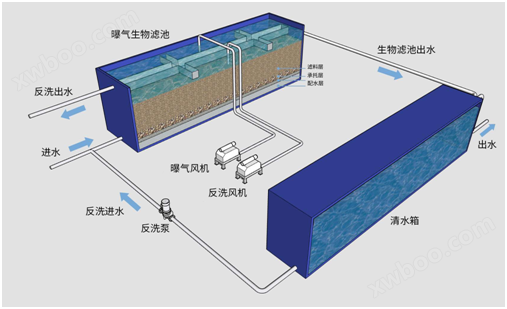
Process principle:
Aerated biological filter (BAF), which achieves the removal of pollutants such as SS, nitrogen, phosphorus, and organic matter in water through physical adsorption interception and biodegradation. Wastewater flows through the filter layer, and pollutants in the water are adsorbed, intercepted, and degraded by microorganisms attached to the filter layer, thereby achieving water purification.

technological process:

System composition:
(1) Preprocessing system
The sewage entering the biological aerated filter is first treated by a pretreatment system to remove impurities and large suspended particles. Setting up a pretreatment system can effectively prevent the problem of filter clogging in the filter, ensuring long-term stable operation of the equipment.
(2) Main body of biological aerated filter
The biological aerated filter consists of a water distribution system, a support layer, a filter material layer, and an outlet tank. Through the adsorption, interception, and biodegradation of the filter, nitrogen, phosphorus, organic matter, and SS indicators are effectively reduced, and the effluent quality meets the discharge standards.
(3) Aeration system
The filter adopts a blast aeration system for aeration and oxygen supply. Aerobic microorganisms on the filter material grow and reproduce in large quantities under aerobic conditions using organic matter in the sewage. Highly active aerobic microorganisms remove pollutants through biodegradation, thereby reducing the content of organic matter and ammonia nitrogen pollutants in the water.
(4) Backwash system
After a period of operation, the filter layer of the equipment may experience increased head loss and blockage due to the retention of a large amount of detached biofilm and insoluble suspended particles. Therefore, regular backwashing of the filter is required to ensure the stable operation of the equipment. The backwashing method is a combination of air and water backwashing.
Processing effect:
Design and selection can be made according to the needs of the owner, so that the effluent meets the Class A discharge standard or Class IV surface water standard, and the treatment effect is stable, meeting the requirements of effluent quality.
Technical advantages:

Product specifications:

Application areas:
Water management in river and lake basins;
Black and odorous water pollution control;
Upgrading, renovating, and expanding urban sewage treatment plants;
Emergency management of water pollution incidents.

